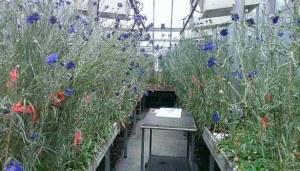For the “Applied Module at External Organizations” (AMEO) the 2nd semester Ecotox students complete an eight-week internship, either performed at an external university, governmental or industrial research institute to apply the competences achieved during their study. Several students used this opportunity to explore new places in Germany, others went out into the big, wide world. This time, Verena Sesin tells us about her internship at Environment Canada in Ottawa, Canada.
An ounce of action is worth a ton of theory
I moved about 6000 km westwards to Ottawa in order to cooperate with scientists of Environment Canada. In a nutshell, I spent two months over there assessing the life cycle of more or less beautiful, treated flowers in greenhouses during the week, and living the Canadian lifestyle on weekends. All in all, my time in Canada was a wonderful experience I would repeat if somehow possible. If you like to gain insight in my experience, keep on reading!
What Environment Canada is researching:
This department of the Government of Canada aims for preserving and enhancing the quality of the natural environment. Located at the National Wildlife Research Centre at Carleton University Campus, the research group of Céline Boutin studies the protection and conservation of terrestrial and wetland habitats within agroecosystems. As the name of the research institute indicates, only native wild plants are used for the running studies.
What I actually did:
Counting flowers and seedheads
A greenhouse full of Viola arvensis was my workroom every Monday and Thursday for assessing the effects of low levels of herbicides on these entangling flowers. They were sprayed with either 1 % or 5 % of the recommended dosages for agricultural application which simulated the amount of herbicide reaching non-target native vegetation when a nearby field is sprayed. For the assessment, both biomass and reproduction aspects were determined. Flower and fruit production was observed over several weeks being responsible for endless flower and seedhead counting.
Measuring giant, exuberantly growing flowers
Comparable to the Viola experiment, low levels of herbicides were also applied to Centaurea cyanus and Silene noctiflora. In order to assess the influence of competition with each other, they were planted in different quantities and combinations. Besides biomass and reproduction also growth over time, height and diameter were determined. Not that easy with plants being three heads taller than me.
Mixing the triple chocolate cookie dough
Unfortunately, it was only cookie dough at first sight. In reality, I mixed different types of soil and filled the soil mixture into pots as test systems for another experiment with native plants. Preparing the soil mixture is always the first step of an experiment with plants. Good mixing skills are essential to guarantee a homogeneous test system. In fact, it feels like playing in a sandbox and can be very recreative between mind challenging tasks. In this particular experiment, it was later investigated whether the exposure to glyphosate affects pollen quality.
Giving grass a new haircut
For a long running biodiversity study different types of grass was hoarded, fostered and identified. The plants had emerged from soil seedbanks which were collected from different contaminated wetlands and fields with the aim of assessing effects of contaminant loads on the native vegetation. Some plants which could not be identified in the seedbank pots at first sight were transplanted in individual pots for further growing. However, sometimes grass subspecies are so similar to each other that only DNA analysis provides a reliable identification.
How living in Ottawa was:
The capital of Canada is a lovely place to live, offering many parks and water bodies for outdoor activities as well as numerous bars and clubs in the city centre. Canadians really fit their stereotype of being extraordinarily nice which is why it is very easy to meet locals.
Highlights of my Canadian life:
- FIFA Women’s World Cup Canada 2015 at Lansdowne stadium
- Vacation feeling at Mooney’s Bay Beach
- Biking and longboarding alongside the Rideau Canal
- Poutine as midnight snack




